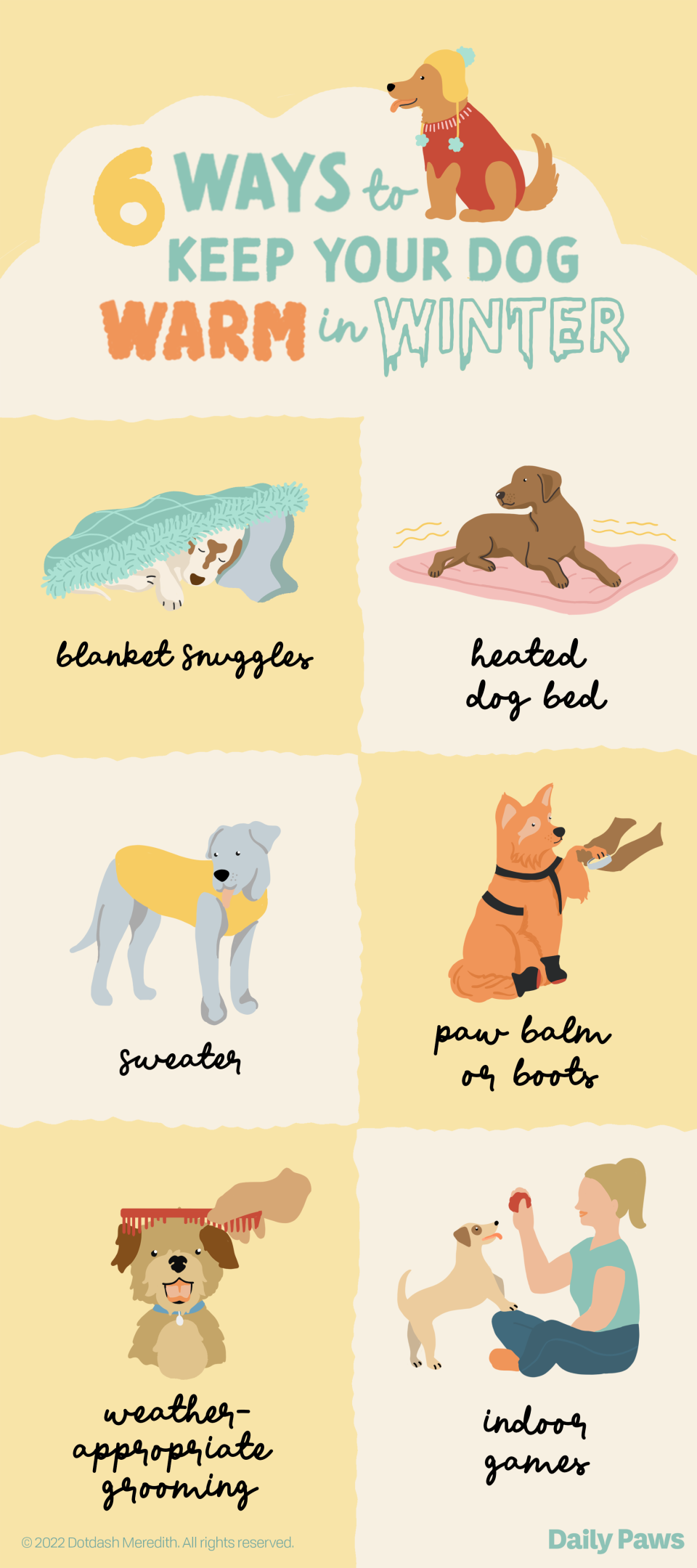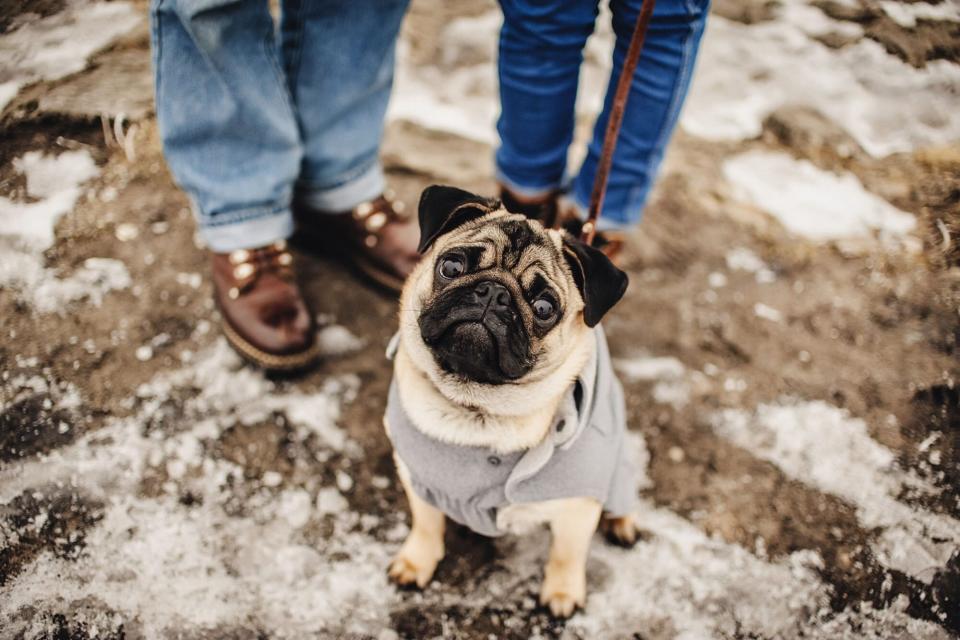8 Tips to Keep Pets Safe During Extreme Winter Weather
As temperatures around the U.S. plummet to historic lows, it's important to keep in mind that our pets need extra protection when it comes to cold weather. Winter safety for dogs and cats—especially in below-freezing temps—will mean making some immediate adjustments to your pet's routines that reflect the weather. Here are our top tips for how to keep your furry friends safe and warm when it's cold outside.

Grace Canaan
1. Protect Your Pet From Frostbite
Your cat or dog will need extra attention when temperatures are super cold. Paws especially should be protected from the freeze, since it's the part of your pet's body that doesn't have protective fur to keep warm. If your pet is picking up their paws off the snow or ice, it's probably too cold for your pet to be outside. Even cats who are used to spending time outdoors should have a cozy place to warm up, as extreme temperatures mean Kitty should come in when it's cold (especially overnight). Time to get inside and warm up by the heat register or in a heated bed.
RELATED: 13 Heated Cat Beds for Ultimate Kitty Comfort
2. Be Careful With Salt and Ice Melt
As if the the threat of hypothermia and slick roads and sidewalks weren't enough, the chemicals used in common salt and ice melt can put your pet in danger of salt toxicity or chemical poisoning. There are several kinds of pet-safe ice melts that can reduce the harm for your pet, but even if you take care to use a non-toxic option, streets and other sidewalks outside your own domain may still pose a threat. Take extra care to wipe snow and ice off paws with a towel or scrub off with a paw washer when coming inside—their pads can be easily dried out and irritated by ice melt, and your dog or cat can become very sick from licking at their paws. Specially-designed booties for dogs can help keep paws safe (if you can get your pet to actually wear them, that is).
RELATED: Why Do Dogs Eat Snow?
3. Watch for Signs of Hypothermia
Both cats and dogs can suffer from this condition when temperatures drop, so learn the signs of hypothermia and how to treat it quickly during cold snaps. It's possible to remedy a slight drop in your pet's temperature with warm blankets and warm (not hot!) drinks like chicken broth. But severe drops in temperature can cause pets to collapse and even die. A sweater or wind-proof jacket can help your pup stay warm during potty breaks outside, but time outdoors should be limited (especially for puppies, dogs who are small, or elderly animals).

Serhii / Adobe Stock
RELATED: Keep Your Canine Warm All Winter With These Cold-Weather Essentials for Dogs
4. Supervise Animals Around Bodies of Water
Ice presents another incredibly dangerous predicament for curious cats and dogs who want to explore their surroundings. Keep your pet leashed when out on walks near ponds, lakes, and rivers to avoid accidents like these. Have a swimming pool that froze over? Keep it securely covered, and watch pets closely in the backyard. They can easily fall through the thin ice like this Texas pup did in his frozen pool.
5. Take Care to Regularly Moisturize Your Pet's Dry Winter Skin
Just like us humans, dogs and cats can get dry skin in the winter time, especially when cooped up indoors as the temperatures drop. Luckily, caring for dry skin is pretty easy maintenance. While you don't need to bathe your pet very often, using a calming oatmeal shampoo when you do can help ease the itch. Applying coconut oil to your dog's coat is another home remedy to try, along with a vet-approved fatty acid supplement. And easiest of all, use a humidifier throughout your home to increase humidity in the air (your own skin will thank you, too!).
6. Prevent Dehydration Even When It's Cold Out
While it's a common misconception, pets (and people) can still get dehydrated in the winter even when it's not swelteringly hot outside. Always carry a bottle of water along with you for walks and make sure your pet is drinking enough at home and outside (and make sure their water bowl doesn't freeze over!). According to Bond Vet, a good way to check your pet for dehydration is to gently grasp a bit of your pet's loose skin on the back of their neck. If the skin springs back into place, your dog is hydrated. If not, it's time for them to take a drink of water ASAP. You can also check their gums to make sure they're a hydrated, healthy pink color.
RELATED: The Best Heated Dog Bowls For Your Cold Weather Pooch
7. Consider Weather-Appropriate Grooming
Our pets need their furry coats to keep them warm when the temps drop, so you may want to consider a longer hairstyle during the colder months of the year. Skip the summer cut and try not to shave your pets (unless there's a legitimate medical reason). Especially if you have a double-coated dog like a golden retriever, Newfoundland, or Siberian husky—shaving their coat can make keeping warm and regulating temperature in general really difficult.
8. Keep Your Pets Indoors
While most kitties are indoor cats, it's a good idea to keep pets of all kinds inside when it's cold out. Especially when temps start to drop below 30 degrees F. Generally if it's too cold for you outside, it's too cold for your pets! When you can't take your dog for a walk outside, consider indoor activities you and your pet can do together to pass the time and make sure they're still getting adequate exercise to combat unhealthy wintertime weight gain.
RELATED: Do Cats Get Cold? How to Keep Your Cat Warm This Winter

